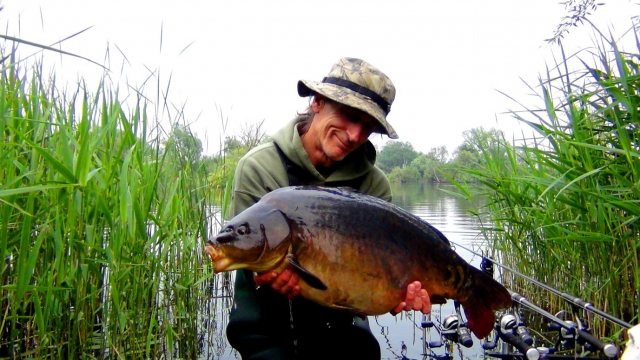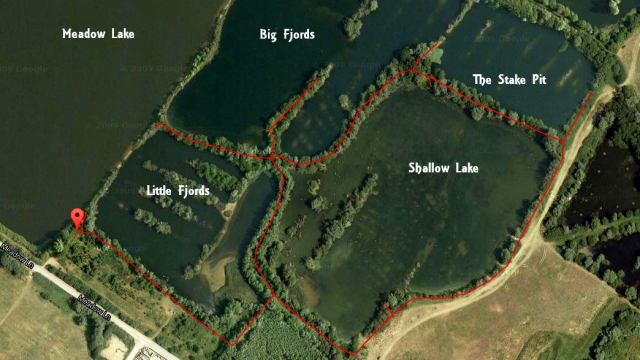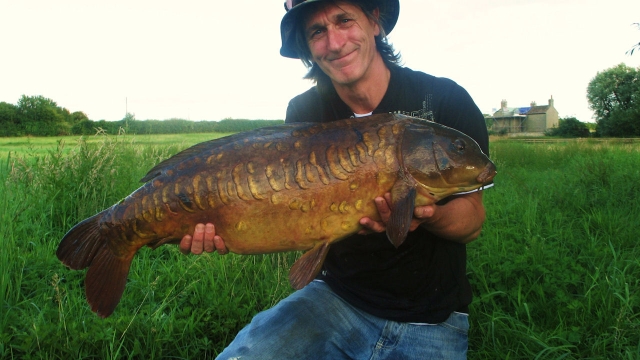
It was approaching the middle of June the glorious 16th, the day when the rivers once again become our hunting grounds and for the last two years this is where I spent my annual mid-June two week fishing holiday. In 2011 I was on my local stretch of the river Cam and got lucky within 30 minutes landing Bullseye at his best weight of 34.8lb followed by a string of hits over the next months including the awesome Linear. In 2012 I spent it being blown flat to the ground by gale force winds beside a deserted fenland drain where at one point during the session I had to quite literally crawl on my hands and knees to get to my rods or risk being blown over, it was a session from hell really and I ended up being rewarded with nothing but bream and coots. So given the memory of that session I decided that this year I would start the glorious 16th on Big Fjords and Meadow Lake, on the St Ives complex, in the relative comfort of the famous Spit swim that separates these two enigmatic waters.
The idea was, given my short reconnaissance of the area previously and the drum beat of the carp grapevine, to fish the tops of the bars and use plenty of bait. I had already stocked up my freezer at home during April/May with sixty kilos of my pre-digested fishmeal/salmon oil fishmeal bait and had mixed up another fifty kilos of dry-mix just in case. Together with this I had also rolled a dozen pots of hard-hookers and corkball-popups using the same mix but with increased binders to toughen them.
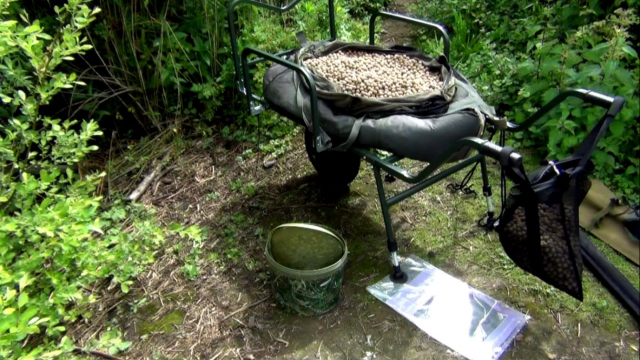
Lessons learned from over thirty years making my own bait give me an edge and there is nothing complicated about it either. Whatever happened to the 80s Bait Revolution? From sweetcorn to high protein specials, particles to peanut bans, mind numbing amino acids and peptide chains? It seemed we were heading for the ultimate bait, nirvana for the carp and the carp angler. But then it all fizzed out when we realised that carp will eat almost anything and given the incredible array of ingredients and attractors we can use coupled with the art of bait application (and the Hair-rig) they didn't stand a chance. Now decades on we have tackle shops full of shiny packets of bait all proclaiming staggering catches (which I don't disbelieve) off the back of that revolution and most carp anglers it seems, are happy with that. However at that time I personally felt that something tangible was lost to me when I was using bait that I have not made or at least devised and this year like no other it was important to get the bait and its application right as places like St Ives are not forgiving of mistakes.
I believe the two most important things that affect my results are location and bait. By location I of course mean finding the carp but finding the carp on low-stocked high-acreage waters can be near impossible at times. So the second rule of location comes into play find areas they might feed in and then let bait application do its job. Bait application can be simple enough, keep the areas you're interested in fishing topped up with bait so its always there and available to the carp should they pass by, train them to expect it and results often follow. However this kind of simple strategy on St Ives has risks attached to it because of the low stock, high acreage and the ever present problem of the Eel population. On many waters bait doesn't lay around too long and so the simple strategy of topping up works well. However as my good friend Martin Lawrence pointed out Bait on St Ives can lay around completely untouched until it rots or until it attracts hordes of Eels, so constant topping up could possibly make the situation worse not better.
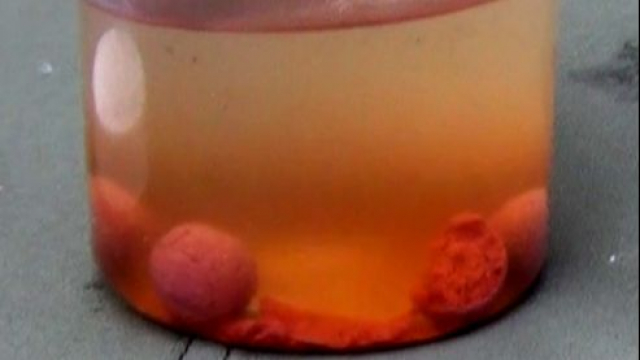
An option I use to help resolve the issue of over-baiting or dead-spots is to use close in margin areas where I can see the bait going. This strategy of feeding close in spots has worked well for me on numerous occasions and when it works it has allowed me to judge exactly how much bait should be going in and when. These spots also give you the advantage of observing the fish and getting a better idea of how many you are fishing for which is always important when it comes to bait application. But there is another approach you can use which doesn't rely on any knowledge of carp visiting your swim or any attempts you might make to judge how much bait is going but only if like me you make your own bait.
Water temperatures were down for the time of year so whilst making the bait I took the decision to reduce the binders in the mix to enable the bait to break down faster and dropped the fish oils completely. This approach relies on the bait and the way its made to control the application process rather than application based on direct observation or guess work. Its a simple approach really but the other way around, “If the bait is not going then the bait has to go”. So by dropping the binders and oils I can ensure that the bait dissolves faster and doesn't lock up and rot. I have been doing this now for many years and the recipes I use are simple and effective allowing me to easily change the way the bait behaves. Ideally I want the bait to break down in the water and start to dissolve after twenty-four to forty-eight hours and you can test this by dropping a few in a pot of water or in your margin.
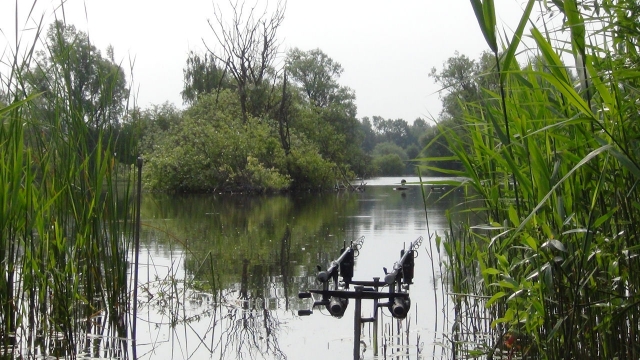
So when I approached The Spit swim with its plethora of spots, difficulty of access and vast acreage I was at the very least confident that the bait would do its job. Getting to the swim was not easy though and needed two trips with the barrow along the spit which was narrow, overgrown and underwater. The area for the bivvy was unusual for St Ives though in that it was roomy and dry but the swim would have to be waded to get the rods in as it was still under feet of water. Once all the kit was sorted I set about finding areas on the tops of the bars out in front of me with a one-ounce lead and the marker rod with a two-ounce lead. Once that was done I popped up to the end of the spit to bait up the area around the gap between the lakes. Its an obvious ambush point as any fish moving between Meadow Lake and Big Fjords would be corralled into this area giving you a much higher percentage of fish moving through your baited area. This is the logic I use behind my second rule of location find areas they might feed in or areas they have to pass through. This coupled with good bait application enables you to define your own areas where the carp will stop and feed. You should not ignore weedbeds either as they have the same effect on the carp, corralling them into a certain route. One angler I know used the weedbeds on Fen Drayton Lake in Cambridgeshire to great effect landing many of the resident fish from within 30 yards. He had figured out that if the carp were to enter a certain area of the lake they would have to come down and around the huge weedbed in front of him thus providing him with a higher percentage than average of the traffic moving through his area and increasing his chances.
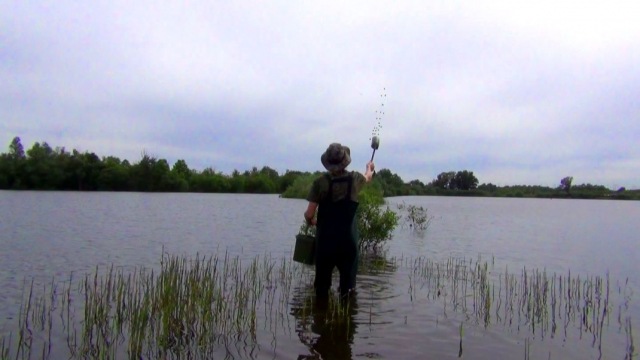
Baiting patterns also matter too along with the areas you are fishing and the traps you set. I lean more towards tight batting patterns than say just spreading it out but I always feed a few off the area too as I believe this helps to zone the fish onto your spot more affectively. Often I will bait up in a line rather than say a circle as I am looking to intercept as many carp as possible passing through the area. The amount of bait you put into a swim is important too and needs some thought because you can easily get it wrong. I would venture to say that this is one of the prime reasons why many carpers fail to catch from active swims, certainly it has happened to me and I have learned from it. Little and often is something I use most of the time preferring to put a bulk amount in at the start and the just keep it topped up. When fishing I am mostly looking for one bite especially on places like St Ives so one to three handfuls is usually the amount I put in preferring to bait larger amounts when I am not fishing. Using little amounts of bait is also less noisy and will scare the carp much less should they be around. Sometimes you will come across areas that fish pass through that you cannot fish due to the nature of the bottom, snags, position etc. In situations like this I will still feed those areas but try and leave a trail to an area/spot nearby which I can fish. These strategies of spreading bait and zoning rely on the natural feeding habit of carp to get them into your area, which is to graze and move. The tighter batting patterns are used to achieve some degree of competition which in turn gives you a higher percentage of pickups. If I am using three rods then I always put one in the margin and the other two out to the main spot, one in and one just off.
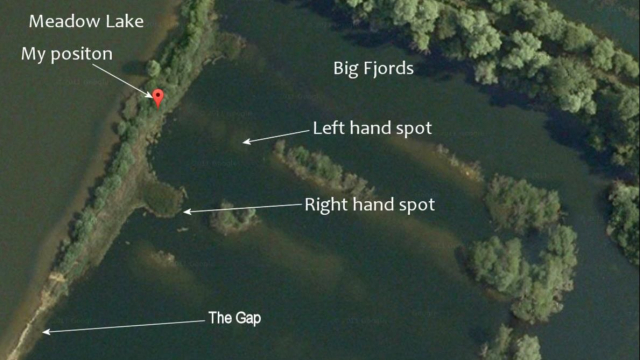
On this occasion though I had two very enticing areas to try on Big Fjords, a bar marked by a long island straight out in front of me and another to my right further up the bank and closer to the gap. I had seen fish moving through these areas and it occurred to me that if they were coming through the gap from Meadow Lake then they were more likely to follow the route to the left and north towards me rather than south as these areas held far more features that provided rich feeding grounds for the carp. Just before dark a carp rolled right out in front of me leaving me a little amazed and much more confident that I had chosen the right area. My other two rods were out in Meadow Lake behind me, one close in right under a bush in three feet of water and the other just past the wide margin ledge where it drops down. I cooked myself up some hot food and settled in for the night exhausted. It had been a long day what with all the trudging around the lakes socializing, fish spotting, the hours spent with the marker rod and baiting up of all the areas I was interested in. Hopefully I had covered all my options and all it seemed all that I had to do now was sit back and wait.
I woke the next morning and made a strong half-cup of coffee, sat back and took in the sounds of St Ives lakes at dawn and the world outside wakening, preparing for their day at work. Floating across Meadow Lake the drone of the nearby road slowly increased in intensity towards rush hour and the inevitable sirens screaming along the road. But for me it was just background noise, my senses were already overwhelmed by the joy of just being there and the knowledge that for at least two weeks I wouldn't have to join them. Now one thing I have learned very quickly on St Ives is to recast often because of the Eels. They can nick your baits without as much as a twitch so you can end up sitting there for a long time without a hookbait if you don't check. Margin rods are great for this as you can quietly lift them out and pop them back in again after checking your rigs. When I pulled out my two rods in Meadow Lake I found that the baits had been stripped so I rebaited and recast all four rods before making first breakfast. The sun climbed its way into the sky dissolving the cloud cover enough to shine through and raise temperatures and with this came the carp. I first spotted them making their way along the bar to my left turning and then swimming straight past me only yards out. Two fish, then I spotted another and then another, oh yes I thought to myself that'll do.
I spent lunch time leading around the spots to get to know them better and popping up to the gap to check the bait I had put in. It had all gone which was a good sign for sure but I prevented myself from putting more in, I wanted to concentrate on the areas out in front of me now that I had seen the fish and got to know the areas better. A little later on whilst coming back from a provisions trip to the car I spotted five or more carp cruising up and down the north bank of Big Fjords. They were on the back of wind getting the high afternoon sun and looked suckers for a floater. I put out some 10mm popups on the wind and waited for them to drift back over the fish and I thought I saw a couple being taken but the rest of them were certainly ignored and floated on past into the margin for the Coots to enjoy. After a while the carp eventually disappeared so I got back to my rods for more leading around and the placing of my baits. Another three handfuls went out onto the bar to my right along with another rod which I had taken out of Meadow Lake. I reckoned my chances of a bite were far greater from Big Fjords than Meadow and so the decision was easy. By early evening I was all sorted out and settled in again when my good mate Martin Lawrence turned up and joined me for a brew and a chat on my progress. We sat and whiled away the moments enjoying the isolation of the spit swim and chatting about the chances of a fish. By late evening with and the sun slowly sinking over the horizon and beautiful sunset on Meadow Lake I decided to turn in.
I was half way through the session and on fish, the weather was playing ball and everything felt right. I had accepted the nature of the game on St Ives and felt relaxed about it too as after all, I knew I could catch carp; I had already caught plenty along the way. So going that extra mile as it were, making that extra effort for that one fish all seemed a natural part of my fishing once again and for that simple fact alone I was grateful.

